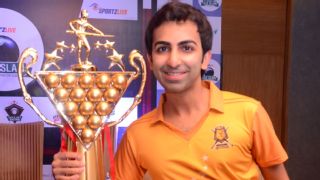At a regular snooker tournament, you probably wouldn't want to breathe too heavily or stir in your seat and run the risk of breaching the library-quiet setting. Enter Cue Slam - the latest in a train of sporting leagues to hit the prime time television slot, which ditches the loaded silence that envelopes cue sport playing halls and changes out of the the wine waiter-like bowtie look.
For a sport cradled in the country, minting world titles by the year, recognition has been grossly under-cooked. Some of the anonymity that cue sport wallows in is self-inflicted and the Indian league, which will take its first shot on Saturday in Ahmedabad, is looking to change just that. By marrying snooker and its simpler, more popular cousin pool into a league, and by dumping stuffy dress code conventions, hushed tones and turning up the music volume, cue sport is shaping up for a much-needed, slightly delayed shot at resurrection.
"The idea is to tear down barriers," says Prasad Mangipudi, executive director of Sportzlive Entertainment, who are the official license-holders of the Premier Badminton League (PBL) and have acquired long-term rights for Cue Slam.
"We don't want anything coming between the spectator and the live match experience - dress code, audience etiquette, or sinfully long games. Players will turn out in colorful team jerseys instead of formals and waistcoats and have a maximum of 20 seconds to play a shot and the audience is free to cheer, boo or whistle. We're here to break the silence."
There will be five games per tie - three six-red snooker and two nine-ball pool games, with the stop clock deciding the winner of 10-minute frames. Former Asian billiards champion Sourav Kothari believes this is the perfect format to get audience hooked.
"Initially when there were talks of playing a 15-red snooker I was not too happy since I felt it would be bad for TV viewership. But with this fast-paced format there's going to be drama, action and some sledging too maybe. Unlike in the case of other sports where the ball is always in motion, we're actually hitting a stationary ball so we have to go the extra distance to engage and appeal to the audience."
A total of 25 players were picked at the draft which includes big names like 16-time world champion Pankaj Advani, Welsh star Daren Morgan, seven-time European snooker champion Kelly Fisher, apart from Kothari and women's world snooker championship silver medalist Vidya Pillai.
"The quality of players will get better with every edition," Mangipudi says. "To get bigger international players we'd have to pay them more than what they'd get out of a tournament. We've only managed to compensate icon players (one player in each of the five teams, picked at $15,000) suitably this time. It won't be before year three or four that we can actually break even."
Starting out as a one-city based league in its inaugural edition, the 350-seater Rajpath Club Playing Arena in Ahmedabad, which will have two tables (one for snooker and pool each), is a much more contained venue, just like the sport demands, than ones used in most other leagues. Taking the league to more cities and bringing in more players, Mangipudi promises, figures prominently among future plans.
"For middling players or those at the threshold, this is the perfect springboard. Lesser-known sports like us need live television just to break perceptions and be taken seriously," says Kothari.

Confessing that her family is yet to wake up to the idea of watching her turn out in a bright orange Chennai Strikers jersey in a snazzy league on live TV, Vidya tempers the apprehension with a measure of optimism. "It's a big, big step. Of course it's just the first year and we're still looking at how it will turn out. Maybe once my family sees me on TV, it might hit them."
The primary challenge in getting the league - with an operating cost that hovers around roughly six crores - off the ground has predictably been sponsorship.
"The bigwig corporate houses haven't been willing to come on board so this year it's being almost entirely funded by us," Mangipudi says. "Honestly there's no accurate way to measure return on investment or cost per thousand, which are the questions we faced when we went out seeking sponsors.
"So even out of the many brands which rush to pitch in their support for say IPL, only a handful of around 11-12 brands, according to a research report, have any recall value. The rest are lost in the clutter. This is just our first edition so we have to bear the birth pangs and get the product out in the market, by next year hopefully sponsors should be up to speed."
With the kind of legacy that cue sport has in the country, a league that shuns what holds it back from stepping into people's minds and living rooms, is what it needs right now.
"The sport is at a juncture where it needs to be sold to the audience and this league could do wonders in at least getting that started," Kothari adds.
"It's time we made some noise."

